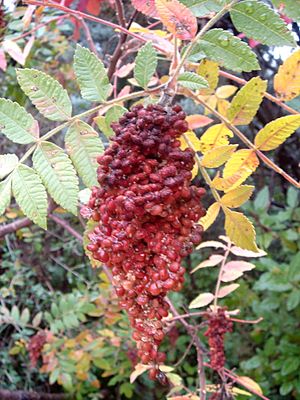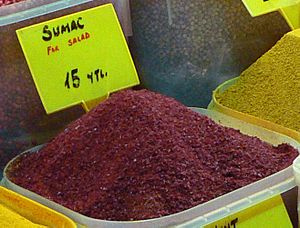Sumac facts for kids
Quick facts for kids Sumac |
|
|---|---|
 |
|
| Sumac fruit in fall | |
| Scientific classification | |
| Kingdom: | |
| (unranked): | |
| (unranked): |
Eudicots
|
| (unranked): |
Rosids
|
| Order: | |
| Family: |
Anacardiaceae
|
| Genus: |
Rhus
|
| Type species | |
| Rhus coriaria |
|
Sumac, also known as sumach, is a type of flowering plant. These plants are usually small trees or shrubs. Their leaves grow in a spiral pattern around the stem.
Sumac plants have small flowers that grow in spikes. These flowers can be greenish, creamy white, or red. Each flower has five petals. After the flowers, the plants produce fruits. These fruits are small, reddish, and grow in clusters. They are called "sumac bobs" and are a type of drupe.
Contents
Growing and Using Sumac
People grow different kinds of sumac plants for various reasons. Some types, like the fragrant sumac or staghorn sumac, are grown as ornamental plants. This means they are planted because they look nice in gardens or landscapes.
Sumac as a Spice and Drink
The reddish fruits of a sumac plant called Rhus coriaria are often dried and ground into a powder. This reddish-purple powder is used as a spice in Middle Eastern cuisine. It adds a tart, lemony flavor to dishes. You might find it sprinkled on salads or meat.
In Arab cuisine, sumac powder is used to decorate meze dishes like hummus. It's also a common ingredient in Falafel. In countries like Syria and Palestine, sumac is important in traditional dishes such as Kubah Sumakieh and musakhan. Many cuisines, including Afghan, Indian, and Iranian, add sumac to rice or kebab. It's also a key part of the spice mix called za'atar.
In North America, two types of sumac, the smooth sumac and the staghorn sumac, are used to make a drink. This drink is sometimes called "sumac-ade" or "Indian lemonade." To make it, the sumac fruits are soaked in cool water. Then, they are rubbed to get out their flavor. The liquid is strained and sweetened to make a refreshing drink. Native Americans also traditionally used the leaves and fruits of these sumacs for various purposes.
Sumac for Dye and Tanning
The leaves of some sumac plants contain a substance called tannin. Tannin is used in a process called vegetable tanning. This process helps turn animal hides into Leather. Leather made with sumac tannin is known for being flexible, light, and having a light color. One famous type of leather made this way is morocco leather.
Sumac was also used as a dye. If sumac dust got wet, it could create a strong purple color. This was especially important to know when shipping sumac with other goods, like white marble, as it could stain them.
Other Uses for Sumac
Some beekeepers use dried sumac bobs as a fuel source for their smokers. These smokers help calm bees.
The stems of sumac plants have a soft center called pith. This pith can be easily removed. This makes the stems useful for making traditional Native American pipes. They were often used as pipe stems in the northern United States.
Did you know that dried sumac wood can glow under special light? It fluoresces when exposed to long-wave ultraviolet light.
Images for kids
See also
 In Spanish: Rhus para niños
In Spanish: Rhus para niños








